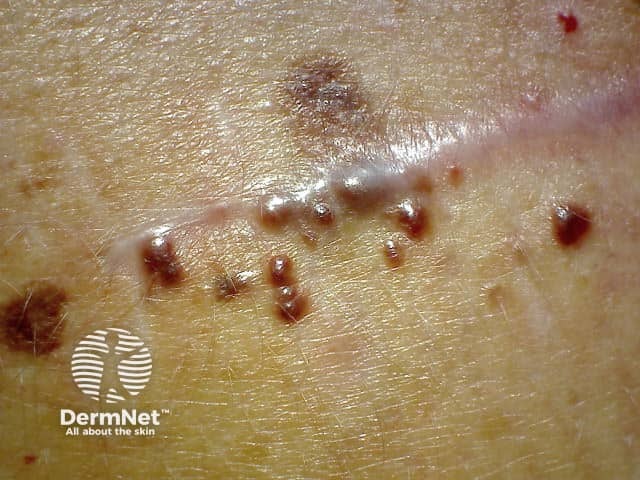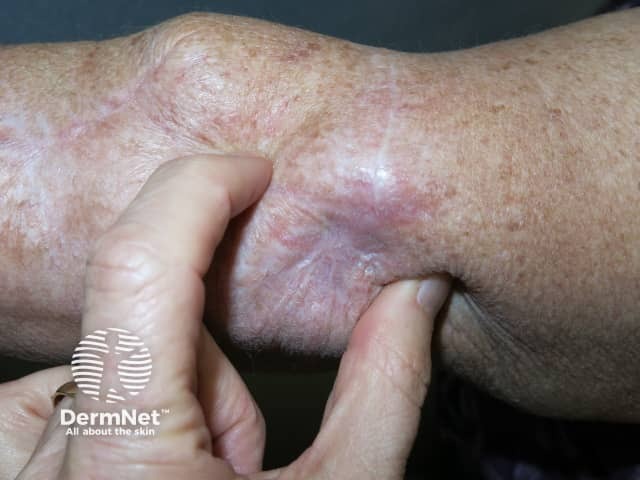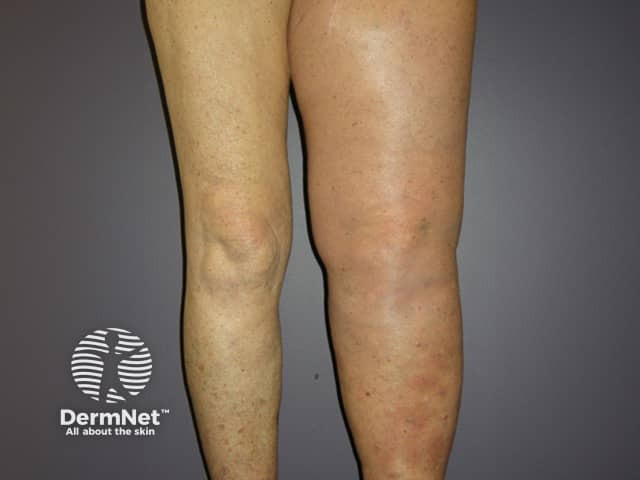Main menu
Common skin conditions

NEWS
Join DermNet PRO
Read more
Quick links
Treatments Lesions (cancerous)
Author: Anoma Ranaweera B.V. Sc; PhD (Clinical Biochemistry, University of Liverpool, UK), 2011, updated March 2020. DermNet Editor in Chief: Adjunct A/Prof. Amanda Oakley, Dermatologist, Hamilton, New Zealand. Copy edited by Gus Mitchell.
Introduction How it works Key clinical-trial evidence Ipilimumab in combination with nivolumab Adjuvant ipilimumab vs high-dose interferon-alpha 2b Pembrolizumab vs ipilimumab Adverse events Dosage and administration Contraindications Drug interactions Use in specific populations Overdosage
In March 2011, ipilimumab (YERVOY™; Bristol-Myers Squibb) gained US Food and Drug Agency (FDA) approval for the treatment of adult patients with stage III to IV melanoma unresponsive to previous therapy (stage IV disease, metastatic melanoma) [1].

Metastatic melanoma

Metastatic melanoma

Metastatic melanoma
Regulatory pathways that limit the immune response to cancer are becoming well characterised. Ipilimumab is a fully human monoclonal antibody that activates the body's immune system to fight melanoma by inhibiting the cytotoxic T lymphocyte-associated antigen 4 (CTLA-4) molecule [1,2].
CTLA-4 is a molecule on T-cells that plays a critical role in regulating natural immune responses. The presence of CTLA-4 suppresses the immune system's response to disease, so blocking its activity stimulates the immune system to fight the melanoma.
Three previous early-phase (phase II) clinical trials have shown that treatment with ipilimumab results in a one-year survival rate of 47% to 51% for people with stage III or IV melanoma, which is almost double the number not on this treatment [3,4].
Ipilimumab has also being tested in advanced (phase III) trials by itself and in combination with vaccines, other immunotherapies (such as interleukin-2), and chemotherapies (such as dacarbazine). Overall response rates ranged from 13% with ipilimumab plus vaccine in patients with stage IV disease to 17% and 22%, with ipilimumab plus dacarbazine or interleukin-2, respectively, in patients with metastatic disease. Responses have been long-lasting, with more than one-third of ipilimumab-treated patients with advanced melanoma experiencing a long-term survival benefit.
Recently published results of a randomized, controlled phase III trial have shown a first-ever significant overall survival benefit with ipilimumab compared with a cancer vaccine comprising HLA-A*0201–restricted peptides derived from the melanosomal protein, glycoprotein 100 (gp100) in patients with metastatic melanoma, previously treated unsuccessfully with aldesleukin, dacarbazine, temozolomide, fotemustine, or carboplatin [5]. Ipilimumab, at a dose of 3 mg per kilogram of body weight, was administered intravenously with or without gp100 (2mg peptide by deep SC) every 3 weeks for up to four treatments.
Based on these results, the US FDA granted marketing approval for ipilimumab as second-line treatment for metastatic melanoma in adult patients. The FDA noted in its approval announcement that the common adverse effects that can result from autoimmune reactions associated with ipilimumab use include fatigue, diarrhoea, skin rash, endocrine deficiencies (gland or hormone), and inflammation of the intestines (colitis). Severe and some fatal autoimmune reactions were seen in 12.9% of patients treated with ipilimumab. Because of the unusual and severe adverse effects associated with ipilimumab, the therapy was approved with a Risk Evaluation and Mitigation Strategy to inform healthcare professionals about these serious risks. A medication guide has also been provided to patients to inform them about the therapy's potential adverse effects.
The safety and efficacy of nivolumab in combination with ipilimumab and nivolumab monotherapy for the treatment of advanced (unresectable or metastatic) melanoma were evaluated in a phase 3, randomised, double-blind study [6].
A total of 945 patients were randomised to receive nivolumab in combination with ipilimumab (n = 314), nivolumab as monotherapy (n = 316), or ipilimumab as monotherapy (n = 315).
Patients in the combination arm received nivolumab 1 mg/kg over 60 minutes and ipilimumab 3 mg/kg over 90 minutes administered intravenously every 3 weeks for the first 4 doses, followed by nivolumab 3 mg/kg as monotherapy every 2 weeks.
Patients in the nivolumab monotherapy arm received nivolumab 3 mg/kg every 2 weeks.
Patients in the comparator arm received ipilimumab 3 mg/kg and nivolumab-matched placebo intravenously every 3 weeks for 4 doses followed by placebo every 2 weeks.
Treatment was continued as long as clinical benefit was observed or until treatment was no longer tolerated. Tumour assessments were conducted 12 weeks after randomisation then every 6 weeks for the first year, and every 12 weeks thereafter. The co-primary outcome measures were progression-free survival and overall survival.
At a minimum follow-up of 60 months, the median overall survival was more than 60.0 months (median not reached) in the nivolumab-plus-ipilimumab group and 36.9 months in the nivolumab group, as compared with 19.9 months in the ipilimumab group (hazard ratio for death with nivolumab plus ipilimumab vs. ipilimumab, 0.52; hazard ratio for death with nivolumab vs. ipilimumab, 0.63).
Overall survival at 5 years was 52% in the nivolumab-plus-ipilimumab group and 44% in the nivolumab group, as compared with 26% in the ipilimumab group.
No sustained deterioration of health-related quality of life was observed during or after treatment with nivolumab plus ipilimumab or with nivolumab alone.
Thus, among patients with advanced melanoma, sustained long-term overall survival at 5 years was observed in a greater percentage of patients who received nivolumab plus ipilimumab or nivolumab alone than in those who received ipilimumab alone, with no apparent loss of quality of life in the patients who received regimens containing nivolumab.
The currently approved adjuvant ipilimumab dose of 10 mg/kg IV was more toxic and not superior in efficacy to interferon-alpha 2b. Instead, adjuvant therapy with ipilimumab 3 mg/kg benefitted survival versus high-dose interferon-alpha 2b with significant improvement in overall survival [7].
1,670 adult patients with resected cutaneous melanoma were randomly assigned (1:1:1) to ipilimumab 3 mg/kg (n = 523), high-dose interferon-alpha 2b (n = 636) or ipilimumab 10 mg/kg (n = 511).
Comparison of ipilimumab 5 mg/kg versus high-dose interferon-alpha 2b used an intent-to-treat analysis of 1,051 cases and showed significant overall survival difference in favour of ipilimumab 3 mg/kg (hazard ratio [HR], 0.78; 95.6% repeated confidence interval [CI], 0.61–0.99; P = 0.044; Relapse free survival: HR, 0.85; 99.4% CI, 0.66–1.09; p = 0.065). For ipilimumab 10 mg/kg versus high-dose interferon-alpha 2b (n = 989), trends in favour of ipilimumab 10 mg/kg did not achieve statistical significance.
Treatment-related adverse events grade ≥ 3 occurred in 37% of patients receiving ipilimumab 3 mg/kg, 79% receiving high-dose interferon-alpha 2b, and 58% receiving ipilimumab 10 mg/kg.
KEYNOTE-006 was an open-label, multicentre, randomised, controlled, phase 3 study done at 87 academic institutions, hospitals, and cancer centres in 16 countries [8].
Patients (n = 834) were at least 18 years of age with Eastern Cooperative Oncology Group performance status of 0 or 1, ipilimumab-naive and histologically confirmed advanced melanoma with known BRAFV600 status with up to one previous systemic therapy.
Patients were randomly assigned to intravenous pembrolizumab 10 mg/kg every 2 weeks (n = 279) or every 3 weeks (n = 277) or four doses of intravenous ipilimumab 3 mg/kg every 3 weeks (n = 278).
Pembrolizumab treatment continued for up to 24 months.
Median overall survival was 32.7 months (95% CI 24.5–41.6) in the combined pembrolizumab groups and 15.9 months (13.3–22.0) in the ipilimumab group (hazard ratio [HR] 0.73, 95% CI 0.61–0.88, p=0.00049).
Median progression-free survival was 8·4 months (95% CI 6.6–11.3) in the combined pembrolizumab groups versus 3·4 months (2.9–4.2) in the ipilimumab group (HR 0.57, 95% CI 0.48–0.67, p<0.0001).
Grade 3––4 treatment-related adverse events occurred in 96 (17%) of 555 patients in the combined pembrolizumab groups and in 50 (20%) of 256 patients in the ipilimumab group; the most common of these events were colitis (11 [2%] vs 16 [6%]), diarrhoea (ten [2%] vs seven [3%]), and fatigue (four [<1%] vs three [1%]).
Pembrolizumab continued to show superiority over ipilimumab after almost 5 years of follow-up.
Ipilimumab can result in severe and fatal immune-mediated reactions due to T-cell activation and proliferation [8]. These are:
In the event of any of these adverse events, ipilimumab should be discontinued and treatment initiated with systemic corticosteroids, i.e. prednis(ol)one or equivalent. Upon improvement, corticosteroids should be tapered gradually.
Vitiligo has been reported as an adverse effect of ipilimumab. Vitiligo has been thought to be a good prognostic factor in metastatic melanoma.
See also Cutaneous adverse effects of checkpoint inhibitors.
The recommended dose of ipilimumab is 3 mg/kg administered intravenously over 90 minutes every 3 weeks for a total of four doses [8].
For any moderate immune-mediated adverse reactions or for symptomatic endocrinopathy, the scheduled dose of ipilimumab should be withheld. For patients with complete or partial resolution of adverse reactions (Grade 0–1), and who are receiving less than 7.5 mg prednisone or equivalent per day, ipilimumab should be resumed at a dose of 3 mg/kg every 3 weeks until administration of all 4 planned doses or 16 weeks from first dose, whichever occurs earlier.
Ipilimumab should be discontinued permanently for any of the following reasons:
None have been reported [8].
No formal drug-drug interaction studies have been conducted with ipilimumab.
There are no adequate and well-controlled studies of ipilimumab in pregnant women. Ipilimumab should be used during pregnancy only if the potential benefit justifies the potential risk to the fetus (Pregnancy Category C) [1,8].
No data are currently available on overdosage with ipilimumab.
Approved datasheets are the official source of information for medicines, including approved uses, doses, and safety information. Check the individual datasheet in your country for information about medicines.
We suggest you refer to your national drug approval agency such as the Australian Therapeutic Goods Administration (TGA), US Food and Drug Administration (FDA), UK Medicines and Healthcare products regulatory agency (MHRA) / emc, and NZ Medsafe, or a national or state-approved formulary eg, the New Zealand Formulary (NZF) and New Zealand Formulary for Children (NZFC) and the British National Formulary (BNF) and British National Formulary for Children (BNFC).